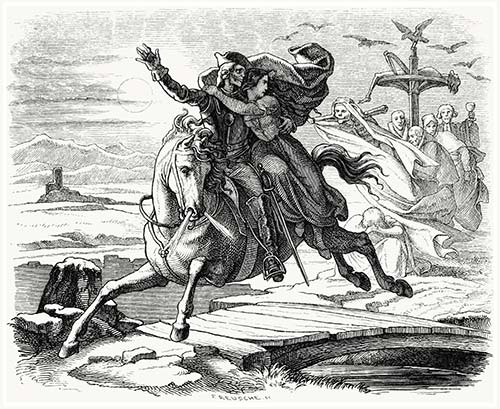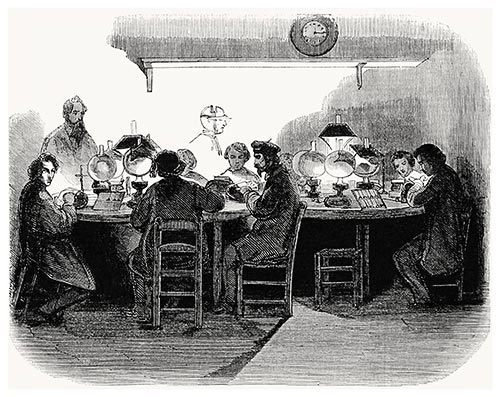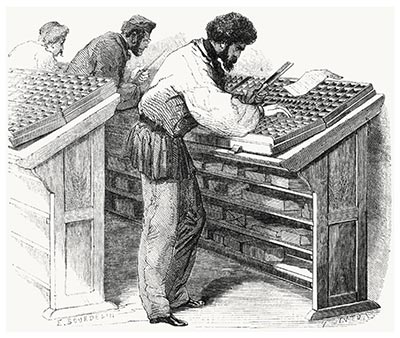L'Illustration, a Weekly Newspaper How It Was Done

L’Illustration was a French weekly newspaper created just one year after the Illustrated London News, from which its publishers drew some of their inspiration. It met with great success throughout the remainder of the nineteenth century and well into the twentieth, thanks to its editorial policy offering information about the world at large and, of course, to its dedication to let illustrations play a prominent part in the exposure of newsworthy events. It also managed to attract some of the most renowned artists and craftsmen of its time. The last issue to bear the original title was released in 1944. On March 2, 1844, however, L’Illustration was celebrating its first birthday, and on this occasion it published the following article, entitled “Les mystères de L’Illustration.” Beside indulging in hyperbolic self-praise, it allowed readers to get a glimpse at what happened behind the scenes and to better understand the process which resulted in that illustrated newspaper spread out before them.
The Mysteries of L' Illustration
Let not this title frighten the most timid and delicate among you: don't worry, dear subscribers, I merely want to let you know today how L'Illustration manages every week to solve the problem of existing. After showing you two of the three main action centers where the ideas which give it birth are conceived and carried out—namely, the editorial office, the engravers' workshop, and the printing house—I wish, in very few words, to give you some little known details about the different intellectual and material operations through which the editors, artists, engravers and printers of your newspaper must take turns. If this matter is of no interest to you, don't read what follows.
It was on March 4, 1843, (a day to be forever remembered) at three forty-seven, that the first issue of the first year of L'Illustration came out of its mother's womb—Messrs Lacrampe & Company's machine. Giving it birth had been long and laborious, but despite some apparent weakness, the newborn suggested a robust constitution and competent observers were not to be misled: they predicted its future would be long and glorious. What other prediction was accomplished more swiftly? Only just had it come into being that the young L'Illustration proved itself worthy of the beautiful name its family had given it. Before the end of its first month, it worked enough wonders to astonish the world. Never had a newspaper made so much progress in so little time. The great news spread with lightning speed from one end of the world to the other. In less than a year, L'Illustration truly became a universal newspaper.[1] Is it necessary to remind you of what it did to deserve its success?… If it wasn't equally fortunate in every one of its endeavors, you must grant that it didn't stop at any obstacle, that no sacrifice was too great. Besides, shouldn't we forgive youth for its lack of experience and the few mistakes that came with it?
Wonder instead at its ability to offer you fifty-two issues as varied and thorough as those it presented you with during its first year, and ask me what means allowed it to achieve such an incredible result, for it is this question that I shall try to answer.

Illustration by H. F. Plüddemann for G. A. Bürger's "Lenore" ballad.
Like all the great powers here below, L'Illustration has courtiers; the capital of its large kingdom is Paris; it set up the seat of its government 33 rue de Seine; ministers chosen with rare discernment rule in its name. But, in addition to these sworn in and responsible dignitaries, it has in every French town and abroad a number of voluntary subjects who, eager for its favors, sigh for this blissful moment when they are allowed to give it, through pen or pencil, a striking token of their affectionate devotion. It receives every day, along with addresses of congratulations, detailed accounts and original drawings of any important event which occurred on our planet during the week. The cabinet regularly meets from noon to six in the evening, it examines the communications it received, tears up and burns those which seem insignificant and submits to thorough discussion those it hopes to put to good use. Once the meeting is over, couriers are sent in every direction. Some run to artists to ask them for drawings, others rush to the residences of writers responsible for explanatory texts on the same day. Since the creation of L'Illustration, traffic has almost doubled in Paris. Haven't you ever run into that famous cabriolet which travels all over the city, going this way and that with such frightful speed? You could hardly see it when it shot past you, faster than the unearthly horse from the Lenore ballad. That's L'Illustration's favorite horse! It takes with its rider the clever executor of the supreme council, whose name must have struck your ears more than once.
It's not enough for L'Illustration to be informed at the very moment anything happens, it needs to know what is about to happen. This mystery I am not allowed to reveal. Therefore I shan't tell you how the prophets of your newspaper manage to know the future. Don't ask any more about it, and follow me to place Saint-André-des-Arts.

Let's walk together into this narrow, damp, and dark street which joins the place Saint-André-des-Arts to the rue de La Harpe and which is named rue Poupée. Having walked half-way down this street, we'll stop at number 7, in front of an old house recently color washed, and even oil-painted. Old age makes it lean a little, but have no fear, the foundations are strong. It was built in a time when architects still thought their work should last for more than one generation. Let's admit it, though: if our forefathers had the good sense not to suffocate in some bijou apartments, they had no notion of what we call comfortable. These apartments are large and well-ventilated, but how steep and dangerous the stairs that lead to them! So the wife of Mr. Chairman used to rest her cute little hand on this crude iron banister, her pretty feet tread without fear or hesitation these damp tiles. Our ladies today wouldn't bring themselves to live in such a house. Everywhere does the upper middle class leave its old dwellings to the working-class. Financiers, magistrates, and lawyers are giving place to industry.

Industry needs room indeed, it can barely make itself comfortable in these vast reception rooms of yesteryear. Take a look at the engraving workshop of L’Illustration: every seat is taken, everywhere the light comes through, it is avidly cut off by a group of artists upon whom the master keeps a relentless watching eye. In the evening, the tables near the windows are given up, the engravers—who are all required, in turn, to work through the night—gather around the circular tables regularly lining the room. It is a most curious sight. The beams of the large lamp which stands at the center of each table go through glass globes filled with water, casting such a bright light upon the hands, the faces, the burins and the woodblocks of every engraver that all the rest of the room seems plunged in deep darkness. Dazzled, one gropes along toward these radiant beacons. It looks as one of the most colorful of Rembrandt's paintings.
I won't tell here the history of wood engraving: somebody else, more qualified than me on such matters, will undertake this interesting task. I'll merely summarize some general information about this art of modern origin without which L’Illustration wouldn't have the good fortune to meet your favor.
The artist draws with an ordinary graphite pencil on a piece of dry, even, and lightly whitewashed boxwood, as he would on a piece of paper. Once it has been assessed and accepted, the drawing is immediately taken to the main engraver's workshop, of which an accurate picture can be seen below. It is engraved at once upon arrival, without pause or respite, night and day, as the work must often be completed in less than forty-eight hours. The process is quite simple, but carrying it out requires great skill. It consists of removing with burins of various sizes every part of the drawing which must remain white. It is completely different from intaglio engraving: the copperplate or steel engraver carves into the plate the very lines the wood engraver leaves in relief; in other words, the copperplate engraver doesn't touch any of the parts which must remain white, whereas the wood engraver leaves untouched every part that must be black.
Not only is this workshop busy night and day, but when necessity commands, a drawing is cut in two or four pieces which are engraved separately and which, after they have been carefully glued together again, are then retouched and completed by a dexterous hand.
Once the engravings are completed, they are sent right away to a distant neighborhood where they are always impatiently awaited. So let's cross the Seine and betake ourselves to the very center of the Cour des miracles, not far from the passage du Caire. Some other time, we'll show you the most beautiful printing house currently standing in Paris, the famous yard where elementary schools replaced the shelters of beggars and scoundrels from the Middle Age, these large workshops where several hundreds of workers are constantly busy composing, correcting, or printing the masterpieces of contemporary French typography. Today, we'll just tell you how the newspaper is printed.

It is Friday: the newspaper has been fully completed since the night before. All that's left to do now are a few minor corrections. Whoever among you has never seen a printing house? You all know, I suppose, that each compositor has in front of him a number of cases of various sizes filled with lead characters. His eyes are almost constantly focused on the manuscript and his hands know so well where to find all the letters of the alphabet, the periods, commas, spaces, etc., that they fetch them of their own accord without ever making any mistake. A steel instrument, the composing stick, is used to arrange the letters and set the line spacing. When a certain number of these lines have been put together, they form a matter. A roller coated with glue and loaded with ink is then used on this matter, a sheet of slightly damp paper is applied, and, using a brush, a proof is obtained, which the author and editors will check for grammatical and typographical mistakes. After these corrections have been made, on Thursday, the compositor arranges the matter into pages, in an order decided and given in advance. This order is sometimes called disorderly, but it should be known that, to produce decent prints, we have to fit all the engravings of any given issue on pages 1, 4, 5, 8, 9, 12, 13, and 16. In consequence, illustrated articles are not always found where logical order would have them. Blocks of lead temporarily take the place of woodblocks, which are not yet finished and will only be delivered the following morning. Two pages make what is called a form, and eight forms put together make sixteen pages, that is, one issue.
Nothing extraordinary so far. But on Friday morning, the engravings are delivered and then a new work begins, which is somewhat difficult to explain and known in the trade as making ready.
Relief engraving has over intaglio engraving the great advantage of allowing the printing process to happen at the same time and in the same manner as that of type. But, in order to achieve such a result, it must be submitted to a fairly long preparation. First, engravings and type are made perfectly level, then the engravings are overlaid. This operation is more important than is usually thought, for upon the overlaying depends entirely the final effect of an engraving: a masterpiece of Messrs. Andrew, Best, & Leloir, if poorly printed, would be regarded as the rough draft of an unskillful apprentice even by experts.
A wood engraver is not granted the same resources as a copperplate engraver: his burin only lets him produce solid blacks and whites and no halftones. To give a wood engraving some sort of shading, it is necessary to tone the black parts in varying degrees. That is the overlaying job, which is long and difficult. The pressman first pulls a proof on light cardboard of the engraving which is to be printed. With a sharp instrument, he then removes from this cardboard the parts of the engraving which shouldn't be completely black. The lighter the intended tone, the deeper he will carve into the cardboard. This cutting or carving of sorts once completed, the cardboard is firmly pasted to the mechanical part which presses the paper sheet on the forms composed with engravings and type. It is, therefore, easy to conceive that an engraving exactly matching the cardboard will be applied more or less pressure depending on how deeply the cardboard was cut, and as a consequence will display tones of various intensities. Oftentimes this initial work is not enough and hours must be spent pasting pieces of paper on the cardboard parts which are not prominent enough, and carve some more into those which are too thick.

Meanwhile, overlaying is completed, and the last corrections are done. A signal is given and wheels start turning: with each revolution a copy of L’Illustration slides, fully printed and of its own accord, between the two cylinders. This beautiful and curious machine, of which we'll some day give you a true to life depiction, gets through more work on its own than twenty men could. Without it, our subscribers couldn't be served all in one day, and where would we be after a few months? It prints 600 copies per hour, whereas, in the same time, eight workers on a hand press could only print 200.
As copies get printed, they are, on Saturday morning, taken to the binding workshop where more than fifty people are busy folding and wrapping them. From there, some copies go to the post-office, others are immediately carried away by messengers in charge of delivering them to their subscribers within Paris. Some go back rue de Seine, No. 33, to the subscription office where they'll be sold separately as part of monthly collections or volumes. Then printers, binders, messengers, etc., all take a few days rest or move on to other business until the next issue claims their time.

Alone, the editorial board and the engravers never rest. The present isn't to be worried about anymore, the future must be taken care of. I won't reveal the mysteries of the projects which you should see come to fruition during this new year: this would be taking your greatest pleasure away from you, that of being surprised, and I love you too much, dear subscribers, to play such a nasty trick on you! Rest assured, however, that you will be even more amazed and happy in 1844 that you must have been in 1843. To keep up to date with everything that happens in the world, to try to anticipate everything that will happen, to bring together in the pursuit of a common goal activities scattered to the four corners of the big city for our readers' greatest satisfaction, that is the task of the editorial board, the learned assembly which never closes the meeting. Before them, articles pertaining to any sort of subject, short stories, novels, drawings, engravings, ballads, etc., come to be assessed. Don't ask me their names, they persist in keeping hidden, as they say, under the cloak of anonymity. In the political papers, in the magazines, they can be illustrations, but here, they are L’Illustration.
Introduction and translation by OBI
This article was taken from No. 53 of L’Illustration, first published in Paris by J.-J. Dubochet on March 2, 1844 and later included in vol. III of the complete collection.
